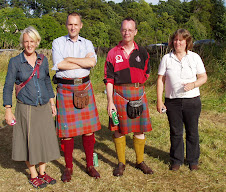Another good day – six rows of Uncia. I should pass row 300
today – that will leave only 100 to go. But it doesn’t mean that I’m 75% of the
way home, because we started with five stitches and the first 150 rows were easy-peasy, compared with what followed.
I should reach the heel flap of the first Mosaic sock today.
And there are only three more edging points to be done on
the Hansel Hap. When my husband finally gets his Package of Care, there should
still be a couple of days while everything else is put in place – visits from
the District Nurse to inject insulin, delivery of weekly pills from the chemist
– during which I hope I could hastily finish it off and block it.
Victoria and Albert are married – I am sorry to have left
you in suspense on that one.
I’ve been thinking, without much result, about how to knit a
wrap-around sweater in the round. (Janine Bajus, “The Joy of Color”, p 96 ff)
You cast on three times the body width (plus ease or whatever). With a steek.
After the ribbing, you start decreasing on the left-hand edge of the steek –
the far edge, as you knit around.
Ah, but wait a moment! What’s happening meanwhile to the
part which will be underneath when eventually the sweater is wrapped around? Can
one steek accommodate two diagonal lines which cross each other? And if not, then what? Writing this down helps the thinking process -- cast on with two steeks? But surely there will be only one cut? I'll go on thinking.
The knitter – not Janine, but one of her students, Karen Hust – says that she took it step by step, and kept notes of what she did “in case I wanted to recreate this shape”. Otherwise, no hints.
The knitter – not Janine, but one of her students, Karen Hust – says that she took it step by step, and kept notes of what she did “in case I wanted to recreate this shape”. Otherwise, no hints.
First draw a schematic, perhaps.
Reading
I’m nearly finished with Tana French’s “In the Woods”, very
much enjoyed. But I think I’ve caught her out in a mistake – always enormously
gratifying to the pedant.
On page 381 (it’s a big book) of the Kindle edition, the
hero is spending a night in the woods, for insufficient reasons, and, among
other things, “bats shrilled across the dig”.
We have bats in Strathardle, more than ever this year. In
the gloaming, that late, long failing of the light on a Scottish summer evening, they
fly and swoop. We stand on the back doorstep and watch them. They are utterly,
uncannily silent. Maybe Irish bats are different, but I doubt it.
Once my sister-in-law, who was a bit given to contrariety,
suggested that we had only one bat which paused behind the garage for a
bit and then came swooping back. This year there were so many that even she
could not have doubted.




Bats do not shrill. We had them in our roof some years ago, and used to stand in the back doorway to watch them come out - they loved to hunt moths in the beam of the outside light. They flew round the house, and passed so close that we could hear the slight sound of their wingbeats, but none of the children were young enough to hear the super-high squeaks they made for their sonar.
ReplyDeleteI can't speak for exotic tropical ones, but the British sort are far too reserved to shrill in any way.
I could hear them until I was 14 or so. Libby (6) heard them when we were watching bats from the tent this summer, but I couldn't.
DeleteI'm pondering on the three times around number for the wrap-around. If you decreased along both edges of the steek, but had plenty to wrap around, would you wind up at the end with a sort of a v-neck that would fold over itself at the bottom, rather than be a point?
ReplyDeleteVictoria and Albert are married!? Spoiler!
ReplyDeleteWouldn't you decrease on each side of the steek, just as you would decrease each side if you were knitting flat pieces? I've been thinking about this since you brought it up (checking Rowan 54 to see what we are talking about) and it seems to me that you would knit a very odd-shaped piece, which would resolve itself as you cut the steek. I hope to try it myself one day!
ReplyDeleteFranklin demonstrates decreasing on both side of a steek here :
ReplyDeletehttp://www.makersmercantile.com/blog/fridays-with-franklin-09-09-2016.html
FWIW Bats navigate by sound (hence the phrase 'blind as a bat')...so they do shrill. But it is generally outside the range of human hearing.
ReplyDeleteI think that by decreasing on both sides of the steek, you are making an overall trapezoid-shaped piece of fabric. The fact that when you cut the steek you will overlap the two edges is really immaterial. As long as you are planning to cut all the way to the bottom so the sides are not connected there, I think it should wrap just fine. Or am I missing something?
ReplyDeleteSome night birds make noise humans can hear(or at least something in the trees in our backyard is), but not bats.
ReplyDeleteSpeaking of kindles, have you looked into kindle unlimited? I am in love with it for entertainment reading (possibly because I can and do read a book in about an hour so under 10 bucks a month for what has been so far a decent selection of books is a great deal for me).
on the steek again - wouldn't it be like a VERY big VERY deep V-neck? In other words, I am agreeing with Camilla above!
ReplyDeleteBeverly near Yosemite
I can hear bats. It's a very small sound, between a tick and a squeak. Don't know what kind of bats we have here.
ReplyDelete